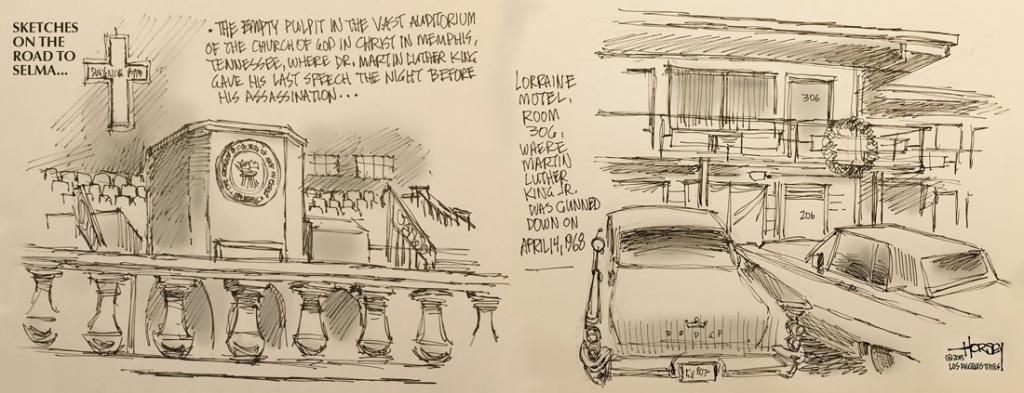Kiwithrottlejockey
Admin Staff
XNC2 GOD

Posts: 32248
Having fun in the hills!
|
 |
« on: March 05, 2015, 09:19:51 pm » |
|
from the Los Angeles Times....The road to Selma: Crime scenes all over the mapBy DAVID HORSEY | 5:00AM PST - Wednesday, March 04, 2015 THE itinerary of a civil rights tour is essentially a long list of crime scenes. THE itinerary of a civil rights tour is essentially a long list of crime scenes.
The crime scenes are everywhere, from the trees where blacks were lynched and the avenues where enslaved people were marched from riverboats to auction blocks, to the countless dots on the map of the South where brave dissenters and utter innocents were beaten or killed with fists, boots, baseball bats or guns. Very, very few of the criminals who perpetrated these crimes were ever brought to justice because local and state governments and the courts were on their side.
On Monday, our busload of 52 civil rights pilgrims arrived in Birmingham, Alabama, a city once known as “Bombingham”. In the 1950s and ‘60s, it was the place where the hardest lines of segregation were drawn and violence was commonplace. It was the city where fire hoses were trained on black boys and girls and attack dogs were loosed on peaceful demonstrators. And it was where, on one Sabbath morning in 1963, a terrorist’s bomb placed at the 16th Street Baptist Church killed four black girls who were straightening their dresses and checking their hair in preparation for Sunday school.
Earlier in Montgomery, the Alabama capital, we had met Georgette Norman, a dynamic, eloquent black woman who recently retired as director of the city’s Rosa Parks Museum. When she talked about how things used to be, she was blunt.
“I grew up in a world of state-sponsored terrorism,” Norman said to us after we dined on Southern food at Martha’s Place Buffet. In her opinion, the country has not really come to terms with the pervasiveness of that terrorism nor with the chronic social and economic after-effects that are still with us. After September 11, Americans are all too cognizant of the terror that has come from outside our borders, says Norman, but “we have yet to claim the terror within”.
Bernard Lafayette, who faced that terror very directly, talked to us at the museum housed in the former Montgomery Greyhound bus station, the site where a white mob viciously attacked nonviolent Freedom Riders in 1961. Lafayette was one of those riders. He recalled the searing moment when members of the mob turned on him and broke three of his ribs while white women across the street, holding babies in their arms, shrieked their encouragement.
At the state Capitol, our tour guide, Aroine Irby, a retired Air Force colonel, went off script as he showed us around the portico where Jefferson Davis was inaugurated president of the Confederate States of America. As a young man half a century ago, Irby said, he had joined the march from Selma to Montgomery and was walking beside a woman and her four children at the moment she was gunned down by a shooter hiding somewhere in the thicket.
When Tuesday came in cold, wet and gray, we were in Little Rock, Arkansas. There, at Central High School, we stood on the street where federal troops were arrayed in 1957 to protect the school’s first nine black students from a racist mob and where, in the hallways, classrooms and cafeteria, no troops shielded those students from the daily harassment inflicted by many of their white classmates. By sunset, we arrived in Memphis, Tenn., at one of the most iconic civil rights crime scenes of all: the Lorraine Motel, where the Rev. Martin Luther King Jr. was assassinated on April 4th, 1968.
On our way to the motel, which, like the Montgomery bus station, has now been turned into a large museum piece, we stopped at the Mason Temple, headquarters of the Church of God in Christ. It was in the temple’s vast auditorium that King gave the last speech of his life. Bob Zellner joined us there. A lifelong civil rights activist and one of the first white members of the Student Nonviolent Coordinating Committee, Zellner was close enough to King to spend time with him in jail. He knew the man as something more than the legend.
“Dr. King was one of the sweetest, most approachable people you could know,” Zellner said. “That someone could shoot him like a deer is still unbelievable to me.”
But, perhaps, not really so unbelievable — certainly not to Zellner, who was nearly killed himself by a furious mob and lost many compatriots who were not as fortunate when they crossed the paths of racist murderers. King had become the most prominent enemy of the system that had created generations of domestic terrorists. If little girls could be murdered, then why not this one pre-eminently dangerous man, Martin Luther King?http://www.latimes.com/opinion/topoftheticket/la-na-tt-crime-scenes-20150303-story.html
|